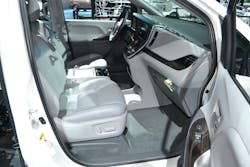University of Extrication: Vehicle Airbags in the Seat Cushion
Topic: Airbag location update
Objective: Improve rescue team understanding of the location and function of the Toyota Sienna front-passenger seat-cushion airbag
Task: Explain how the presence of an undeployed uncommon airbag influences safety and protocols for medical care and rescue/extrication work
Responders, including EMS providers, have been encountering supplemental-restraint-system airbags in vehicles for years—some deployed, but most remaining intact and undeployed. The function and effectiveness of these systems in protecting occupants in vehicle collisions has been confirmed by governmental data as well as those from numerous private sources, which show fewer motor vehicle fatalities and occupant injuries.
As an overall trend, the number of airbags that are installed in late-model vehicles seems to be increasing with each new model year. For responders, the most likely number of airbags that will be encountered in a crash-damaged vehicle today is six. There can be as many as 12 airbags on passenger vehicles. (Note: There are at least 26 locations where an airbag can be found in a vehicle today.)
Beyond the six
The first two airbag locations that responders routinely encounter are the frontal airbags (steering wheel and instrument panel). For side-impact occupant protection, responders are familiar with the third and fourth commonly encountered airbag locations: the driver’s and front-passenger seat-mounted, side-impact airbags. These are mounted in the outboard sides of the seatbacks.
The final two commonly encountered airbag locations are the roof-mounted side-impact airbags that deploy downward from the roofline on each side of the vehicle. Additional rollover protection now is afforded by these roof-mounted airbags when they’re designed to deploy during a rollover as well as during a side impact.
Of course, the challenge for rescue responders is to anticipate that one or more of these airbags will be undeployed when you make patient contact. However, our safety further depends on locating any airbags beyond these six that haven’t deployed while working with the patient and/or completing extrication tasks.
The 2019/2020 Toyota Sienna minivan is an example of a vehicle that has eight airbags, which is the most for a minivan that’s in this class.
In the Sienna, a somewhat hidden airbag is the driver’s kneebag. It’s electronically tied to the driver’s frontal airbag in the steering-wheel assembly. The driver’s kneebag module is positioned low on the instrument panel and centered directly below the steering column.
If the driver’s frontal airbag deploys, the driver’s kneebag will fire off, too. Rescuers who make patient contact with a driver who was involved in a side-impact collision could have a difficult time determining the presence of an undeployed driver’s kneebag (in addition to an undeployed driver’s frontal airbag). The ID marker is the same color as the instrument panel and is situated in a low spot, which makes it difficult to see. Any dash rolling or jacking task would be done near the undeployed kneebag.The eighth airbag in the Sienna is somewhat rare: an integrated, front-passenger seat-cushion airbag. The seat-cushion airbag is completely concealed beneath the seat-cushion upholstery. (The front-passenger seat-cushion airbag is different than a seat-mounted side-impact airbag.)
Seat-cushion airbags have been used by automakers since the 2014 model year. Toyota’s version is designed to reduce forces on an occupant’s chest and abdomen by controlling movement of the occupant’s body during a frontal crash. (The subcompact Toyota Yaris also is equipped with a seat-cushion airbag.)
A seat-cushion airbag and its inflator module, which are positioned beneath the front-passenger seat cushion, deploy upward. As the airbag inflates, it sufficiently swells the forward portion of the seat cushion (below the front passenger’s legs) to hold the seated and belted passenger in the seat. This minimizes the chance of the front passenger sliding forward and off of the seat. The seat-cushion airbag also keeps the occupant from sliding under the seatbelt restraint. (Seat cushion airbags are designed as a supplement to the seatbelt to help to prevent unwanted out-of-position movement of the front passenger during a collision.)
Undeployed, unforgiving
Frontal airbags other than seat-cushion airbags are designed to deploy in the event of an impact with a sudden deceleration that exceeds a predetermined level set by the automaker. Kneebags will deploy when the primary frontal airbag above them deploys. However, Toyota’s seat-cushion airbag won’t operate under any circumstance if the occupant isn’t wearing a seatbelt at the time of the crash.
In the Sienna, the front-passenger airbag and seat-cushion airbag won’t deploy during a frontal or off-angle-frontal collision if there isn’t a passenger seated in the front passenger seat.
Another scenario in which responders likely will encounter an undeployed kneebag and seat-cushion airbag is one in which a vehicle is involved in a low-speed side-impact or low-speed frontal collision. In this scenario, both the driver’s kneebag and the front-passenger seat-cushion airbag will be found undeployed.
Frontal airbags, including kneebags and seat-cushion airbags, also will remain intact if the vehicle rolls over without any frontal impact or if it’s involved in a low-speed frontal collision.
Toyota Sienna Airbag Locations
- Driver’s and front-passenger airbags (frontal)
- Driver’s and front-passenger seat-mounted (side-impact)
- Driver’s and front-passenger side roof-mounted
- (side-impact and/or rollover)
- Driver’s kneebag (frontal)
- Front-passenger seat-cushion airbag (frontal)
About the Author
Ron Moore
RON MOORE, who is a Firehouse contributing editor, recently retired as a division chief with the McKinney, TX, Fire Department and now serves with Prosper, TX, Fire Rescue. He self-published the Vehicle Rescue 1-2-3 training manual and serves as the forum moderator for the extrication section of Firehouse.com . Moore can be contacted directly at [email protected].


